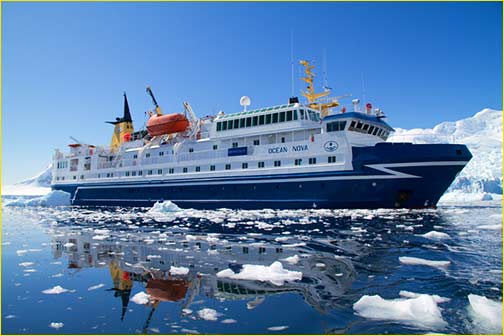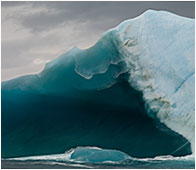Seven of The World’s Leading Photographic Instructors

“Having been to Antarctica with Michael and Kevin, I would say after having traveled the world and shot nearly my entire life as an exhibiting photographer,
it was one of my highlights in my life and I talk about it, all the time. The images and experience of seeing something visionary and nearly extinct from the world,
to see and experience the wildlife and scenery that does not fear humans is amazing.
The images I shot there won me two Smithsonian awards and nearly 18 other international awards”. – Tim Wolcott
The Luminous Landscape has conducted four previous Antarctic photographic expeditions and workshops. In January and February 2015 we will be producing our fifth and sixth trips to the world’s most spectacular imaging location. These two trips, each lasting a week, will be taught by six of the world’s finest photographic instructors (one instructors will switch out for each trip, see below). This is a dream team of photographic experience.
Our workshops are dedicated solely to photography. These are not regular tour ships with a couple of instructors and a handful of photographers among a ship-load of tourists. Each Luminous Landscape workshop expedition is dedicated to photographers and their spouses, and is devoted 100% to exploration, photography and education. We decide when and were we will be for best light and the best subjects and are not subject to a fixed tour schedule.
Fly Over The Drake Passage

Two hours crossing the Drake Passage Instead of Two Days of Rough Seas – Each Way
Visiting Antarctica is as close to visiting another planet as any of us will ever get. It’s a life changing experience that only a very small number of people get to do, and a photographic challenge unlike any other. We have now led photographic expeditions to Antarctica four times over the past eight years.
The problem for most people is that usually getting there means two days on board ship crossing one of the world’s roughest bodies of water, the Drake Passage. Then, at the end of the voyage there’s another two days of rough seas getting back to the southern tip of South America before heading home.
We now offer an alternative. Our expedition operator, Antarctica XXI fly us from southern Chile directly to an Antarctic scientific base, and to our ship, the Ocean Nova (the same excellent ship used on several of our previous Antarctic Expeditions). The flight takes 2 hours in a modern 4 engine commercial jet, instead of two and half stomach-churning days at sea, each way.
Once on board the Ocean Nova we will be in calm coastal seas and even the most seasick prone person should have no problem.
Two Separate Expeditions are Available
These two expeditions are identical in every respect. They only differ by the dates offered, and both occur during the peak of the Antarctic summer, with long warm(ish) days and fantastic long sunrises and sunsets with extensive golden light. Choose the expedition that you wish to join based on the dates that work best for you.
Each trip lasts for nine nights; five nights aboard ship in Antarctica and a total of four nights in Chile prior to and following your time in Antarctica.
The instructors on these trips are some of the best in their field and represent a truly international line up. Art Wolfehas been to Antarctica many times and is known worldwide for his TV series, his incredible photography style and instructing methods.Christian Fletcherfrom Australia is well known for his magnificent landscapes and is an award winning landscape photographer. One look atCharles Cramer’swork and you’ll know you have one of the most talented landscape photographers there is along.Joe Cornishproduces stunning images and hails from the UK, is one of Europe’s most recognized landscape photographers. This will beKevin Raber’ssixth trip to Antarctica. He is a wealth of knowledge on how to shoot in this magnificent landscape. Along on thefirst trip onlyisKatrin Eismann. Katrin is an amazingly talented photographer that will inspire you to see differently. Joining us from New Zealand isJackie Rankenwhose work is simply different and over the edge. Jackie will be joining us for oursecond trip. Please visit the instructors’ websites with the links above and you’ll quickly see that you’ll have an opportunity to learn from the best in one of the most picturesque areas of the world.
Like all of our photographic expeditions this trip to Antarctica is all-inclusive. Fly from home to Santiago, Chile, that country’s capital city, join us at our group hotel, and we’ll take it all from there. Your hotel in Santiago, your commercial flight the next day to Punta Arenas in southern Chile, your hotel that night, your private jet flight to Antarctica, and then five days aboard the Ocean Nova cruising the calm seas of the Antarctic Peninsula are all included. Then on return, the flight back to Punta Arenas, two nights in a hotel there, and your commercial flight back to Santiago are all covered, as are all meals, an open wine bar on-board ship, and all land transportation between hotels, planes and the ship. Nothing is a hassle. Nothing is left to chance. Nothing is an extra.
In addition to our world-class team of photographic instructors the ship’s expedition staff includes experts on all aspect of Antarctic history, geology and biology, and lectures on these topics will be available throughout the voyage, as well as on photography, of course. Even non-photographers will find the trip stimulating and fascinating in every aspect.
These expeditions are open to men and women of all ages in normal good health (no children under 18 please). We will be shooting from the comfort of the ship’s decks as well as cruising aboard Zodiacs, and will be hiking on shore at least twice a day. Landscapes, skyscapes, wildlife, and ruins of whaling stations and scientific stations are to be explored. The weather in late January and early February is at the height of Antarctic summer. A typical day is around 0C (32F), not unlike a January day in New York, Berlin or Toronto.

Costs and Availability
On each expedition there are a total of 67 passengers. There are single, double and triple accommodations. Prices are as follows…
Single Cabins, each with 1 lower berth and private facilities: US $ 18,395 per berth, all-inclusive . Four single cabins are available.
Twin Cabins, each with 2 lower berths and private facilities: US $14,995 per berth, all-inclusive . 27 twin cabins are available
Triple Cabins, each with 2 lower berths and 1 upper berth and private facilities: US $12,995 per berth, all-inclusive . 3 triple cabins are available
Availability is on a first come first served basis. People traveling together as couples will share a cabin. Individuals traveling alone will share a double or triple with others of the same sex, unless they select one of the dedicated Single cabins.
These fees may be paid in installments, and are all-inclusive.
For complete details on both expeditions, please download the Travel Program PDF
To join one of these photographic expeditions, please download and send in theRegistration Form by either e-mail or fax.
The Registration Form can be filled out on your computer or by hand, and then emailed or faxed.
Please see details on the 2nd page of the registration form on where to send the document when it is complete.
Someone from Antarctica XXI will be in touch with you within 24 hours.
These Two Expeditions are Identical in Every Respect. They Only Differ by the Dates Offered
Expedition #1 – January 26 through February 4
A few spaces still avaialble
Expedition 2 – January 31 through February 9
10 Spaces Still Available
An Important Note About Weight Concerns
The good news is that by flying to Antarctica in 2 hours, we avoid spending two days and nights crossing the tubulent Drake Passage. The trade-off for this is that each passager is limited to just 20kg (44 lbs) of luggage – total, checked as well as carry on. This is not an arbitrary number.
The plane that we are using to get from Punta Arenas in Chile to the scientific base on the Antarctic Peninsula is a short takeoff and landing twin-engine jet that carries about 65 people with 20kg (44lbs) of luggage each. That’s all it can carry.
Antarctica XXI have been doing this for more than 10 years. Thousands of people, including a great many photographers have done it. It just takes some packing discipline. For photographers the weight division should be about 50/50 between camera gear, clothes and a laptop. This means about 20+ pounds of each. A few simple suggestions for making this work are as follows.
Firstly, anything that you don’t need on the ship can be safely left in lock-up at the hotel where we are staying in Punta Arenas at the beginning and end of the trip. So, your travel clothes, city clothes etc., and your large suitcase are left behind. You bring a lightweight nylon sports type bag and put your ship-board clothes and toilet article for one week in it. You’ll need a couple of pairs of jeans, a couple of sweaters, a down vest and a pair or nylon waterproof pants and similar jacket. None of this weighs much. Oh yes, socks and underwear. Laundry can be done for you on the ship if needs be.
Camera gear should consist of a main body, a backup body, and about three lenses. 24-70mm and 70-200mm are a minimum, with 14-24mm in addition, or 80-400mm as alternatives. A few primes in this range are another alternative. A polarizer, some memory cards, and that’s about it. A tripod isn’t strictly necessary since they are not used when shooting from the ship. The engine’s vibrations are much better absorbed by ones body. A tripod ashore can come in handy, but it can be a lightweight model with a small ballhead. Even when there are no travel weight restrictions our experience is that large tripods are unnecessary and also unweildy on the zodiacs when going ashore.
Use a light weight back-pack style camera bag. Waterproof is not needed. A canvas briefcase with your laptop and a couple of drives, as well as travel documents, medication etc, completes the picture. Together all of this won’t weigh more than about 25 lbs.
We’d love to have you on one of these expeditions. It takes a bit planning to get your baggage down to 44lbs (20kg), but it definitely is do-able. Many hundreds of photographers have done it before. You can too.
A Free Streaming HD Video
You May Also Enjoy...
Rediscover – Understanding Polarizers
FacebookTweet Understanding Polarizers Care, Feeding & Proper Use There are few more important things that a nature photographer can do to improve his or her

